Earth Rotation and Revolution Teaching Resources
Make teaching about Earth rotation and revolution, how they give us day and night and how they affect the four seasons easy this year! This collection is filled with printable worksheets, Earth's rotation activities, science games and more designed for science teachers and their lesson plans!
This collection of teaching resources is aligned with the NGSS curriculum and has been carefully reviewed by our expert teaching team to make sure every resource is classroom-ready. We're here to make your lesson planning easier with differentiated and editable resources.
New to teaching this portion of the science curriculum, or just looking for new ways to engage your students? Read on for a primer from our teacher team, including a kid-friendly definition of the Earth's axis, an explanation of both rotation and revolution and a look at some key vocabulary terms for teaching all about the Earth!
What Is the Earth's Axis? A Kid-Friendly Definition
Before we can get into rotation and revolution and how the Earth's movements affect the seasons and whether we see dark or light outside, we need to explain the Earth's axis.
Looking for an easy metaphor and definition to explain what the term Earth's axis means? Here's one our teacher team uses with students:
The axis is an imaginary line that goes through the center of the Earth from the North Pole to the South Pole. Picture spinning a basketball on your finger (or trying to, anyway!). Your finger is like the Earth's axis!
Explaining Earth Rotation to Kids — A Simple Definition
Next up is our kid-friendly definition of Earth rotation. Use this to explain what it means to your class:
Rotation means the spinning or turning of an object around its center. In the case of the Earth, our planet rotates or spins on its axis.
How Fast Does the Earth Rotate?
The Earth takes about 24 hours to completely rotate — the length of a full day.
This rotation is what gives people here on Earth our day and our night. When a specific part of Earth faces the sun, it's daytime for that part of the world.
As the Earth continues to rotate or spin, that part of the world moves away from the sun, creating nighttime.

This graphic illustrates how the Earth rotation around the sun affects the amount of light that a particular section of the world gets. It helps explain day and night!
What Is the Earth's Revolution? A Kid-Friendly Definition
Of course, rotation isn't the only thing the Earth does. It also revolves.
Here's a definition that you might use to explain this to your science class:
Revolution means the movement of an object around another object.
When we talk about the revolution of Earth, we're talking about the way that the Earth revolves — or moves — around the sun.
How Long Is the Earth's Revolution Around the Sun?
The Earth revolution around the sun takes just a little longer than a year — about 365.25 days, to be more exact.
This is why we have a leap year on our calendar every four years! The extra day in February helps us make up for that extra quarter of a day that it takes for the Earth to revolve around the sun.
What Are Hemispheres? A Kid-Friendly Definition
When we're talking about the Earth and both its revolution and rotation, it can also be helpful to explain the concept of hemispheres to your students.
Hemisphere is another way to describe half of a sphere. When it comes to the Earth, the hemispheres are literally the equal halves of our home planet.
The northern hemisphere is the top half of the Earth — it's where you'll find the United States — and the southern hemisphere is the bottom half. Pretty simple, right?

The Equator, seen directly in the center of this world map, splits the Northern and Southern hemispheres of the planet.
The two halves are divided by the equator, the imaginary line that runs directly around the center of the Earth horizontally.
There is also a western hemisphere and an eastern one — these two halves of the earth are split vertically by the prime meridian (0 degrees longitude) and the International Date Line (180 degrees longitude).
What Causes the Seasons to Change?
So how about the seasons? What do the Earth's axis and the Earth's axis have to do with winter, spring, summer and fall?
The changing of the seasons is caused by the way the Earth revolves or moves around the sun and because of how it’s tilted on its axis — that imaginary line that runs through from the North Pole to the South Pole.
Earth is tilted at an angle of about 23.5 degrees. As the planet orbits around the sun, different parts of Earth receive different amounts of sunlight at different times of the year.
When one hemisphere of the Earth is tilted towards the sun, that hemisphere receives more direct sunlight and experiences warmer temperatures. This creates summer in that hemisphere.
When that same hemisphere is tilted away from the sun, it receives less direct sunlight and experiences cooler temperatures. This creates winter in that hemisphere.
The opposite hemisphere experiences the opposite season at the same time — so when we have summer here in the United States, people in the southern hemisphere experience winter. During the equinoxes, which occur twice a year, the Earth’s axis is not tilted towards or away from the sun.
This means that both hemispheres receive about the same amount of sunlight. This gives us spring and fall.
- Plus Plan
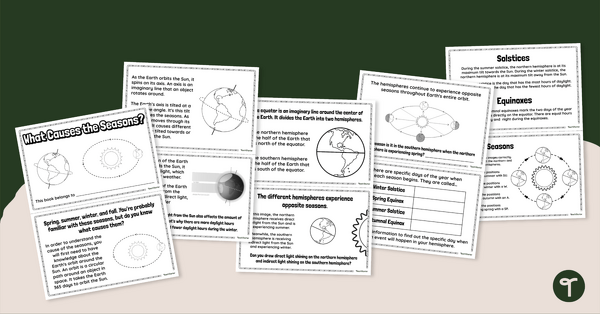
What Causes the Seasons? Mini-Book
Explore what causes the seasons on Earth to change with this printable mini-book.
- Plus Plan
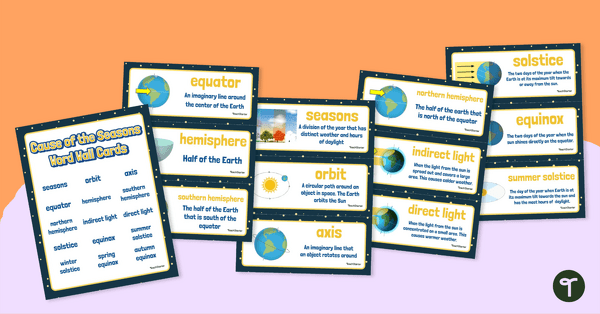
Cause of the Seasons – Word Wall Cards
Reinforce science vocabulary in your classroom with this set of word wall cards that focus on what causes the change of seasons.
- Plus Plan
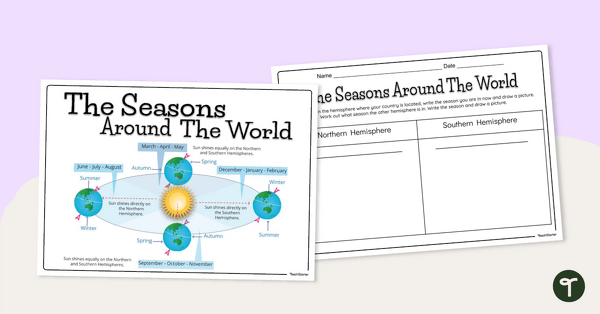
The Seasons Around the World Posters and Worksheet
A diagram showing the Earth's rotation around the sun and the corresponding seasons in the Northern and Southern Hemispheres.
- Plus Plan

Earth's Rotation – Flipbook
Model and explain how Earth’s rotation causes the sun to move across the sky with this interactive flipbook.
- Plus Plan
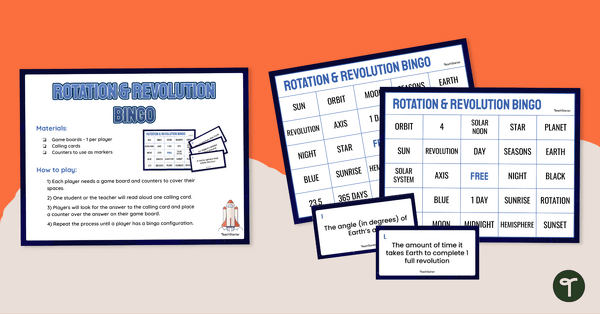
Rotation and Revolution Bingo
Engage your students with a lively game of bingo while learning about Earth’s rotation and revolution.
- Plus Plan
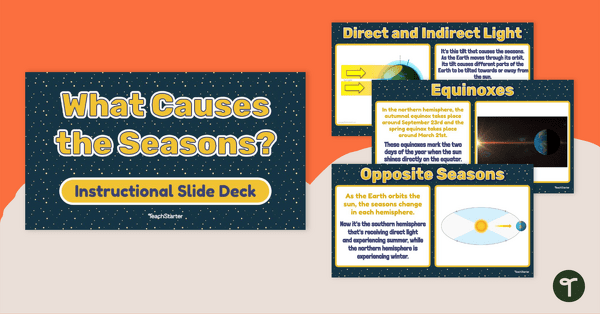
What Causes the Seasons to Change? – Instructional Slide Deck
Explore what causes the seasons to change and learn about solstices and equinoxes with this instructional slide deck.
- Plus Plan
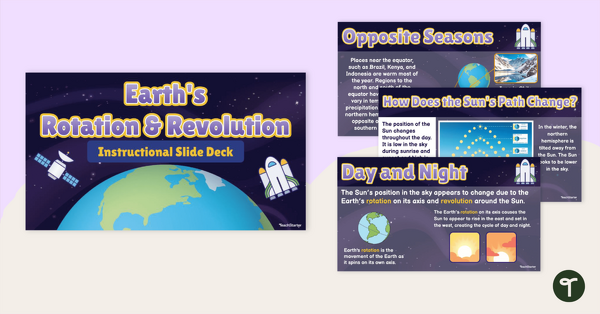
Earth's Rotation and Revolution – Instructional Slide Deck
Explore the difference between rotation and revolution while learning about the day and night cycle, what causes the seasons to change, and more with this instructional slide deck.
- Plus Plan
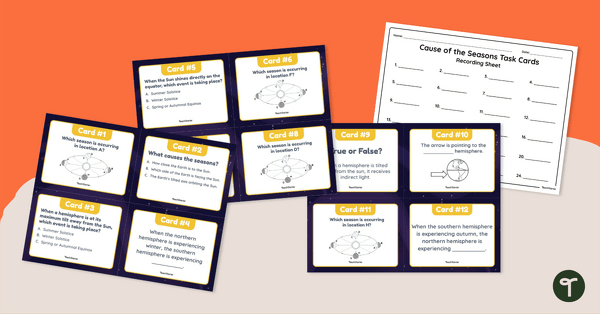
Cause of the Seasons – Task Cards
Demonstrate an understanding of what causes the seasons with this set of 24 task cards.
- Plus Plan
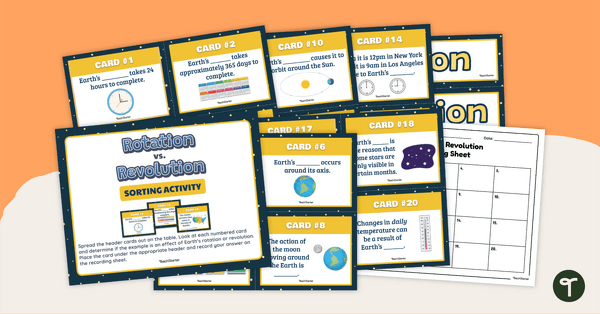
Rotation vs. Revolution – Sorting Activity
Determine if examples are due to Earth’s rotation or revolution with this sorting activity.
- Plus Plan
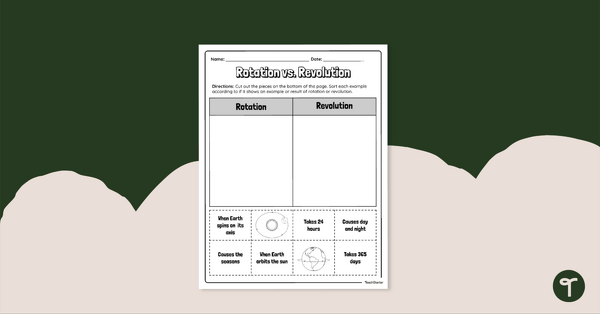
Rotation vs. Revolution – Cut and Paste Worksheet
Demonstrate an understanding of rotation vs. revolution with this cut and paste worksheet.
- Plus Plan
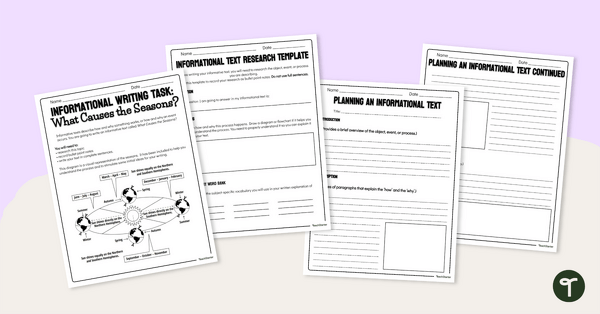
What Causes the Seasons? Informative Text Writing Task
Use this scaffolded writing task to have students write about how seasons change.